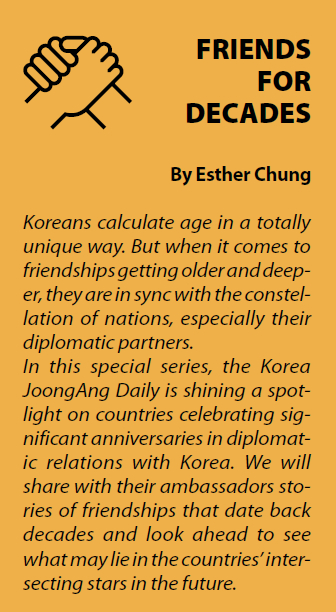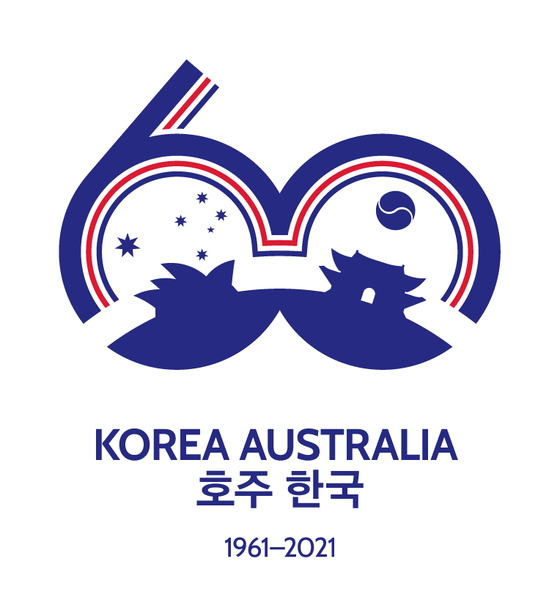[Friends for decades] Korea and Australia look to green-powered future
![Exercise Haedoli-Wallaby in 2019. [ROK NAVY]](https://koreajoongangdaily.joins.com/data/photo/2022/09/24/b2d444e6-092c-4039-af8b-4a9a55a59794.jpg)
Exercise Haedoli-Wallaby in 2019. [ROK NAVY]
Two countries to elevate relations for 60 year anniversary

“Our history of contact between our peoples goes back much further to 130 years or so [when] Australian missionaries came to build hospitals and schools,” said Catherine Raper, ambassador of Australia to Korea.
They included James Mackenzie and Mary Kelly, an Australian missionary couple who landed in Busan in 1910 and traveled across the country to provide medical assistance wherever needed.
Their two daughters Catherine and Helen, born and raised in Korea in their youth, came back to find Seoul war-torn in 1952.
“They both got medical training — one was a doctor, the other a nurse — and they came back to Korea in 1952, while the Korean War [1950-53] was still on, and built a gynecological hospital in Busan that helped Korean women deliver their babies and trained Koreans to deliver the services. To this day the hospital stands, it’s called the Ilsin Christian Hospital,” said Raper. “There is also the earlier generation [of Australians in Korea] who built the Busan Leper Hospital that dealt with people with leprosy, a very difficult disease back in the 1920s and ‘30s.
“I think these are a wonderful part of the story where we were making a very important contribution to building those links between the two nations.”
Like the Mackenzies, the friendships that spanned across the two nations often transcended generations. The same has also been the case for Raper.
Her grandfather, Frederick Arthur Stokes III, chief petty officer in the Royal Australian Navy, was one of Australia’s over 17,000 troops who answered the cry for help from South Korea during the Korean War.
“He was here as part of the Royal Australian Navy in 1952, on destroyer Warramunga,” Raper said. “So I see a really wonderful synergy between him being here and fighting for the very important values shared between the two nations, and allowing the Republic of Korea to have the opportunity to build its society and its economy, and myself coming back 70 years later and seeing the outcomes.”
As the first female ambassador of Australia to Korea, Ambassador Raper arrived in Korea to take on her duties in time for the 60th anniversary of official diplomatic relations between the two countries this year.
To commemorate the anniversary, the leaders of the two countries also met on the sideline of the G7 summit in Cornwall, England, this year, to launch several priority projects in bilateral relations, including elevating the ties to a comprehensive strategic partnership, and a partnership on low emissions technology.
The two governments will be holding this year the biennial meeting of foreign and defense ministers, where key security interests in the Indo-Pacific region will be discussed.
“One important point to make is that Australia is the only country to have a two-plus-two ministerial level with the Republic of Korea besides the U.S.,” said Raper. “This is a strong signal of the investment at a ministerial level, and our shared interest and our relationship.”
The Korea JoongAng Daily recently sat down with the ambassador to recount the milestones in the bilateral ties and hear more about the upcoming partnerships between the two nations aimed to transform the way Australians and Koreans do business, travel for work and fun, and, along the way, try to save the planet.
The following are edited excerpts of the interview.
![Catherine Raper, Australian ambassador to Korea, speaks with the Korea JoongAng Daily at the embassy in Seoul on Aug. 12. [PARK SANG-MOON]](https://koreajoongangdaily.joins.com/data/photo/2022/09/24/d064d471-ec13-44a8-96ab-c323e5768f41.jpg)
Catherine Raper, Australian ambassador to Korea, speaks with the Korea JoongAng Daily at the embassy in Seoul on Aug. 12. [PARK SANG-MOON]
We are very proud to have sent over 17,000 troops here to Korea. Sadly, we lost a number of them here — 339 soldiers [died] and a further 1,216 were wounded. But we felt that it was important that we do our bit, and we continue to be here as an active member of UN Command to continue to contribute to preserving that peace and stability that was so hard-fought for back in the 1950s.
![Members of 4 Platoon, B Company, 3RAR rest near Kapyong the day after the battle in the Korean War, on April 26, 1951. [AUSTRALIAN WAR MEMORIAL]](https://koreajoongangdaily.joins.com/data/photo/2022/09/24/699582e2-9643-4e76-8107-619a349a87ac.jpg)
Members of 4 Platoon, B Company, 3RAR rest near Kapyong the day after the battle in the Korean War, on April 26, 1951. [AUSTRALIAN WAR MEMORIAL]
Building on the foundations from the Korean war, Australia was able, through our export of raw materials, to contribute strongly to the Korean "Miracle on the Han." Our complementary economies have really gone from strength to strength in the 60 years we’ve had formal relationships.
For this we’re inviting partners, including the Korean government, where [all parties] provide funding for projects which can start to provide proof of concept of these low emissions technologies so they can gradually become more commercially on par with existing energy sources.
The Australian government has committed a total of 565.8 million Australian dollars [$412.8 million] to these partnerships, which have been joined by Japan, Singapore and Germany, in addition to Korea.
The details to the partnership with Korea are being worked on, and the final agreement will be announced later in the year. It will shift our relationship from one based on carbon-heavy trade to one built on higher technology and low emissions technology.
![President Moon Jae-in, left, with Australia's Prime Minister Scott Morrison, meet on the sideline of the G7 summit in Cornwall, England, in June. [BLUE HOUSE]](https://koreajoongangdaily.joins.com/data/photo/2022/09/24/2573b175-0d25-4a0a-a1a0-d4f24a66add2.jpg)
President Moon Jae-in, left, with Australia's Prime Minister Scott Morrison, meet on the sideline of the G7 summit in Cornwall, England, in June. [BLUE HOUSE]
[In the upcoming meetings] we’ll also be talking about the United States and how important it is to see the United States’ engagement in the Indo-Pacific region, we’ll both talk about how China is our major trading partner and some of the challenges we’ve encountered in the region.
Later this year, we have two major events scheduled. To highlight excellence and innovation in food and beverage, Australia will be featured at the Seoul Cafe Show in Coex, where we will have an Australian pavilion in the "Roastery Cafe Zone." There will be free Aussie coffee tasting and latte art demonstration sessions by famous baristas. Additionally, we will host an Australia Contemporary Art Exhibition at the Seoul Museum of Art, titled “UN/LEARNING AUSTRALIA.” The exhibition will be held from Dec. 14 to March 6 next year. This exhibition is designed to show diverse aspects of the modern Australian society rather than showing a fixed national or cultural identity. Some 21 contemporary artists and five teams from Aboriginal Art Centre from Australia will be participating.

1889 First recorded contact
The first recorded contact between Australia and Korea took place in 1889 when missionaries from Australia landed in Busan, many of whom built hospitals and schools for the locals. Later, in 1904, Australian photographer George Rose traveled all around the Peninsula, photographing the country and its people.
![Australian missionaries, James Mackenzie and Andrew Adamson, standing with Koreans in front of Tongyeong Mission which is still in place, in this photo dated 1901. [KYONGGI UNIVERSITY SOSUNG MUSEUM]](https://koreajoongangdaily.joins.com/data/photo/2022/09/24/1241dbe8-32fa-4be1-ac7d-0363992c8424.jpg)
Australian missionaries, James Mackenzie and Andrew Adamson, standing with Koreans in front of Tongyeong Mission which is still in place, in this photo dated 1901. [KYONGGI UNIVERSITY SOSUNG MUSEUM]
Australia was the first country after the United States to commit all three branches of its armed forces to the Korean War. From June 29, 1950, to July 27, 1953, there were 10,657 Army, 4,507 Navy and 2,000 Air Force troops for a total of 17,164. Of these, 339 were killed in Korea and over 1,216 wounded. Another 30 became prisoners of war. Of the 339, 42 were classified as missing in action. Efforts to recover their remains are ongoing.
1961 Ties established
The two countries established diplomatic ties in 1961. The people-to-people ties have grown exponentially since then, with about 170,000 Koreans estimated to be living in Australia, as many as 249,000 Koreans visiting Australia, and 187,000 Australians visiting Korea, all as of 2019. The numbers have dropped since the Covid-19 pandemic.
1989 Asia-Pacific Economic Cooperation
In 1989, as vibrant middle powers, Australian and Korean leaders helped establish the regional economic forum, the Asia-Pacific Economic Cooperation. This was the first regional body of its kind, and it built a solid foundation for further economic cooperation within the region.
2012 Haedoli Wallaby exercises
The Australian Defence Force and Korean forces regularly participate in joint exercises. The two have also cooperated under the multinational Proliferation Security Initiative (PSI) since Korea joined the PSI in 2009. The Royal Australian Navy also makes regular ship visits and has held bilateral maritime exercises with the Korean Navy, referred to as Exercise Haedoli Wallaby, since 2012. In 2021, for the first time, Korea participated in Exercise Talisman Sabre, the largest joint training between Australia and the United States.
![Exercise Haedoli-Wallaby in 2019. [ROK NAVY]](https://koreajoongangdaily.joins.com/data/photo/2022/09/24/b2d444e6-092c-4039-af8b-4a9a55a59794.jpg)
Exercise Haedoli-Wallaby in 2019. [ROK NAVY]
The Australia-Korea FTA entered into force in 2014, and today Korea is Australia’s fourth largest trading partner, and Australia Korea’s eighth largest trading partner. Then-Prime Minister Tony Abbott visited Seoul to sign the agreement. Prime Minister Abbott met with former President Park Geun-hye to discuss regional and global security issues. The two nations entered into an agreement the year before to hold a two-plus-two foreign and defense ministers’ meeting every two years.
![Signing of the Korea-Australia FTA in 2014, Seoul, attended in person by Australia's then-Prime Minister Tony Abbott, left, and Korea's then-President Park Geun-hye, right. [AUSTRALIAN EMBASSY IN SEOUL]](https://koreajoongangdaily.joins.com/data/photo/2022/09/24/d154fb3e-9c52-47f1-99d4-833c29148184.jpg)
Signing of the Korea-Australia FTA in 2014, Seoul, attended in person by Australia's then-Prime Minister Tony Abbott, left, and Korea's then-President Park Geun-hye, right. [AUSTRALIAN EMBASSY IN SEOUL]
Australia’s Prime Minister Scott Morrison and Korea’s President Moon Jae-in met in the margins of the G7 summit in Cornwall, England, where the two countries were invited as guests. The two leaders in their meeting agreed to elevate relations to a Comprehensive Strategic Partnership, which would replace the label for the bilateral ties, Emerging Partnership, established in 1999.
BY ESTHER CHUNG [chung.juhee@joongang.co.kr]










with the Korea JoongAng Daily
To write comments, please log in to one of the accounts.
Standards Board Policy (0/250자)